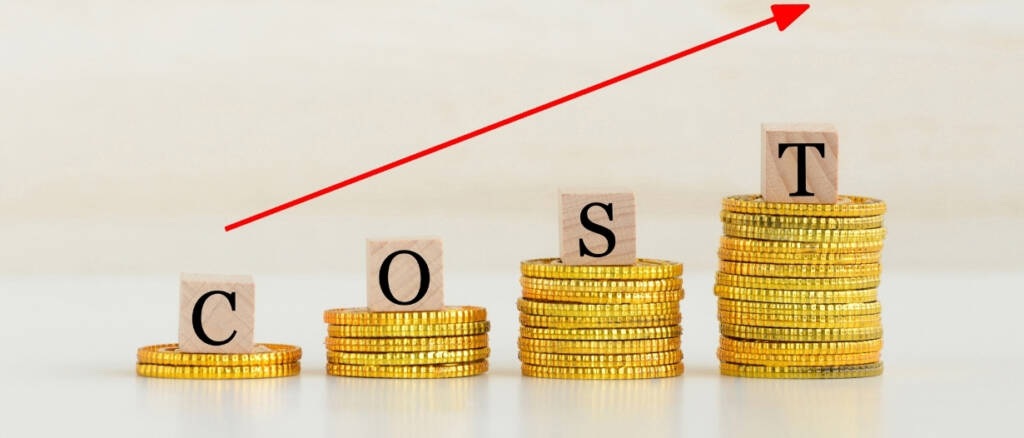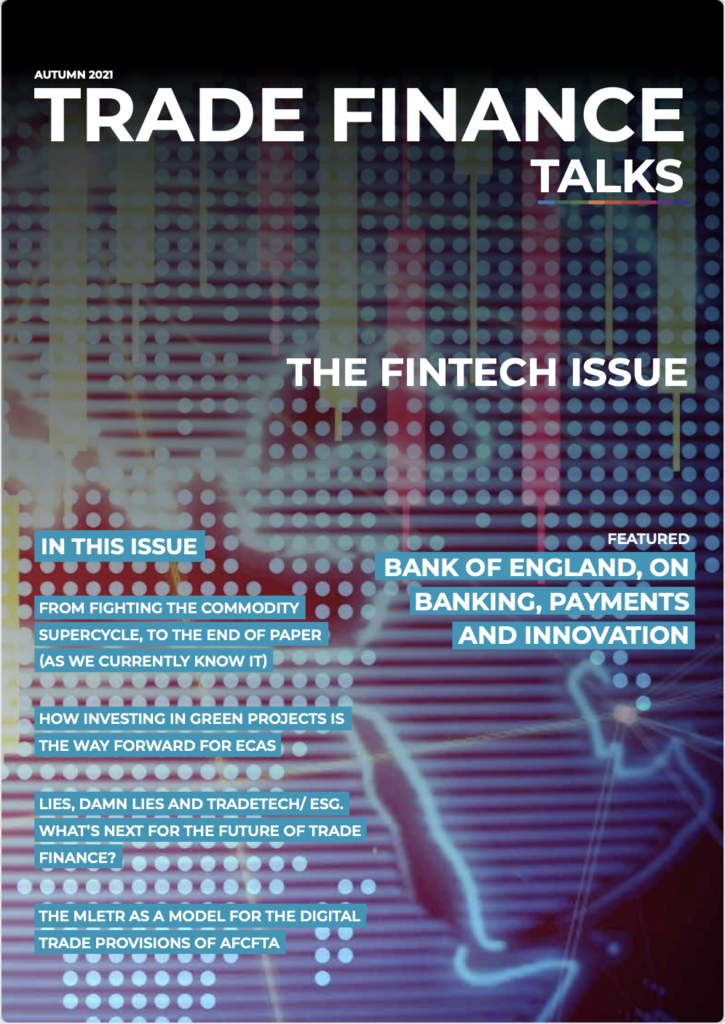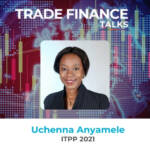Listen to this podcast on Spotify, Apple Podcasts, Podbean, Podtail, ListenNotes, TuneIn, PodChaser
Season 1, Episode 66
Host: Deepesh Patel (DP), Editor, Trade Finance Global
Featuring: John Miller (JM), Chief Economic Analyst, Trade Data Monitor

Today we’re talking about some of the changes in trade in goods volumes over the past 12 months. A lot has changed. We’ve had a commodity supercycle – with prices surging despite low volumes – and global trade tensions have continued amid the pandemic.
World trade of goods has declined some 12% in the last year, representing a loss of $22 trillion USD of trade. Is it all doom and gloom for trade, or will we see a resurgence? Data also lies at the heart of this problem, due to siloed and even duplicated trade data flows. Today I’m catching up with Trade Data Monitor’s Chief Economic Analyst, John Miller.
Market overview and macro trends
DP: Can you please give a brief overview of the commodity market?
JM: As you pointed out earlier, there’s been a spike in prices, which has to do in part with the increased demand as factories kickstart production after COVID-19, even though this might be short-lived, as the Delta variant threatens to slow down production again. In a nutshell, this year’s trade has recovered, and industrial production got back to where it was a couple of years ago. This has created a lot of demand for iron ore to make steel and copper for wiring, as well as all commodities that our industries require.
However, alongside that, we’ve had this bottleneck in shipping for a lot of different reasons, one of which is the fact that the shipping industry has not yet caught up to demand. Even if the commodities are available at the mouth of the mine, it can be challenging to get them to the factory door, resulting in increased prices.
Furthermore, this also distorts the perception of trade, as volumes have actually been falling in many situations. For example, Chinese iron ore imports have been down this year, but prices have increased, making it look like iron ore imports are increasing when that’s not true.
DP: Can you talk us through some of the macro trade updates that we’ve seen?
Merchandise trade
Merchandise trade has recovered, and we’ve actually seen a change in what’s being traded during the pandemic. There are significant surges in demand for goods people can use at home – such as computers, furniture, routers, and technology – and a decrease in demand for goods such as shoes and luggage, with petroleum imports experiencing a downturn as well.
This is starting to change, however, as restrictions ease and people start to leave their homes again, and stimulus policies in the US and Europe are implemented which have kept money in consumers’ pockets. This was really important for consumer demand which, in turn, helped to stabilise trade too, as consumer demand tends to be for goods that are not made in the US, Europe, and the UK, but are mostly imported from Asia – computers, board games, furniture, lamps, etc. Therefore, when basic household demand is strong, trade is strong too.
Travel sector
Trade Data Monitor assembles and counts trading goods, not services. However, there are smart ways in which economists can associate goods with services trade. For example, the wine trade tends to follow how well restaurants are doing, or the luggage trade tends to follow the performance of the travel industry. We have seen a rebound in demand in the travel sector, but it does feel very fragile.
This is not necessarily reflected in the trade numbers. The Delta variant has the potential to undermine and slow down the speed of economic recovery, even though that is not something we have seen – yet. Trade data this year looks pretty good. It looks like the world has gotten back to normal-ish. It is important to note that that has a lot to do with the resiliency of the economies, and a year-and-a-half ago, we didn’t know that we’d be in as good a place as we are now, even if it is fragile. Consumer demand has pretty much held up, and we haven’t seen a great depression because of COVID-19.

Brexit and the new free trade agreements
DP: What’s been the impact of Brexit on UK trade, both from an imports and an exports perspective?
JM: The impact has been pretty minimal. Three of the top five suppliers in the UK market are in the EU, with Germany remaining as the UK’s biggest supplier of goods in the first half of 2021, followed by China, the US, Netherlands, and Belgium.
Imports from China were up 48% compared to 15% from Germany, indicating there is the possibility that China and the US could grab more market share as the UK’s relationship with Europe becomes a little more fraught. The US is now the UK’s biggest market for traded goods by value, followed by Germany, Switzerland, Netherlands, and Ireland. So that’s again, three of the top five export markets for the UK are in Europe. A wide variety of goods, such as cars, pharmaceutical products, and organic chemicals, are shipped from the UK to the US every year.
Nevertheless, Germany is still a substantial market for the UK too. Despite Brexit, tariffs are still the same, and supply chains are still intact, so the UK remains a strong commercial ally and there’s no reason for companies to stop importing from the UK.

The increased cost of having to deal with more regulators
DP: Has the surge in litigation and various anti-dumping measures impacted companies, such as chemical companies?
A lot of companies are looking at their supply chains. Legislation on chemicals force companies to register anything they make in the EU at a substantial cost, around 30,000 to 50,000 euros per chemical. Companies that used to only have to deal with EU regulators are now being forced to deal with UK regulators as well. As a result, companies might now think twice about choosing to be located in the UK, and might choose to base themselves in Amsterdam instead to avoid having to deal with more regulators.
I believe supply chains are going to move more towards Europe to take advantage of the single regulator and not have to deal with two regulators. However, that will take some time to shake out, with companies having to assess costs and talk about a very complicated upstream production of polyethene plastics, which are the base of manufactured goods. Therefore, some expected changes are likely to occur that will be disadvantageous to the UK market.

Could a UK-US trade deal be next?
DP: Are there any potential free trade agreements you think might be particularly interesting?
JM: The Australia-UK trade deal seems like a big deal. UK exports in the first half of 2021 to Australia were USD 3 billion according to our data, which is a substantial amount, and imports were USD 2.2 billion, totalling USD 5.2 billion in the first half of 2021 alone.
One of the most promising trade agreements would be a UK-US free trade deal, which I believe Boris Johnson wants to do. However, the appetite now for free trade deals in the US is very minimal. The hyper globalisation we saw in the 90s and in the 00s is on pause, for now. I believe protectionism sentiment is high at the moment, and there’s more scepticism about trade deals. Nevertheless, it does make sense for the UK to go out and do these deals, as there is still great merchandise and commercial power in many ways.
The Australia – China tension
DP: The tension between Australia and China continues to rise. What is causing this?
JM: There are a lot of regional politics, particularly between Australia and China. Australia is essential, in many ways, to Chinese industrial development. Western Australia provided much of the iron ore that made the steel that built modern China. However, the Australian government is now looking at alternative markets. Trade Data Monitor has recently done some work for the Australian government looking at where else Australian beef and Australian wine could be exported from.
I believe this is part of the move away from hyper globalisation that we’re now seeing, including China looking inward and not being as dependent on markets in the US, Europe, and Australia. There has been a boom in Asian markets, with Vietnam being a huge source of growth for Chinese exporters.
The tension with Australia is something we will see more during this decade, as there are likely to be more political considerations that will impact how countries trade.

China as the world’s biggest importer
DP: China is on the brink, it seems, of overtaking America as the world’s biggest importer. Is that still the case?
JM: We thought it would happen last month, and it hasn’t yet. The title of the largest importer in the world pertains to the place where people or humans are buying the most, which since World War II has been the US. It’s also why the US has had so much leverage in trade negotiations, and why Americans are still the ones who buy the most goods.
Australia has been catching up, however, mostly because of its huge appetite for commodities, notably iron ore to make steel. Additionally, the Chinese market is also growing, and consumers are shipping in more BMWs from Germany, more Château Lafite from the French wine country, and more baseball gloves from Texas. There’s more appetite for goods now among Chinese consumers.
It’s a status China covets: to be the number one importer of merchandise goods. Achieving this will cement that China is the most powerful trading nation the world has ever seen. We believe this is going to happen before the end of the year, in large part due to their appetite for soybeans, iron ore, copper, and other essential commodities. When it happens it will be the biggest story of the century economically, politically, and diplomatically.
DP: How is America reacting to losing its coveted place as the number one importer?
JM: The current political consensus is that the US should import less, so trade is not really on the agenda right now. The Biden administration is not expected to do or say anything about trade, as it seems the Trump administration ended the elite free trade consensus that you cannot win a national election now in the US by campaigning for free trade, it makes you look foolish. Even though free trade creates winners and losers and has contributed to the overall prosperity of the US, it also has, in many ways, crippled thousands of small towns in the middle of the US, which is what got Trump elected, so nobody is going to poke that beast for now.
Looking into a potentially prosperous future
DP: Where do you see the global trade industry going in the next 12 months?
JM: I think one set of winners are Asian countries, such as Vietnam, Malaysia, Taiwan, and Singapore, who have been improving their export manufacturing base to compete with China, and have tempered COVID-19 successfully. Essentially, we’re okay for now: trade has recovered this year as we talked about earlier, and there’s enough demand, even though there is some slowing of growth.
The global trading system, which is underpinned by consumer demand in the US and Europe, but also increasingly in Asia, where economies are more prosperous, is working for now. We don’t think that there will be a collapse like there was in 2020: we think there’ll be some slowing of growth, but essentially strong trading for the next 12 months.












































